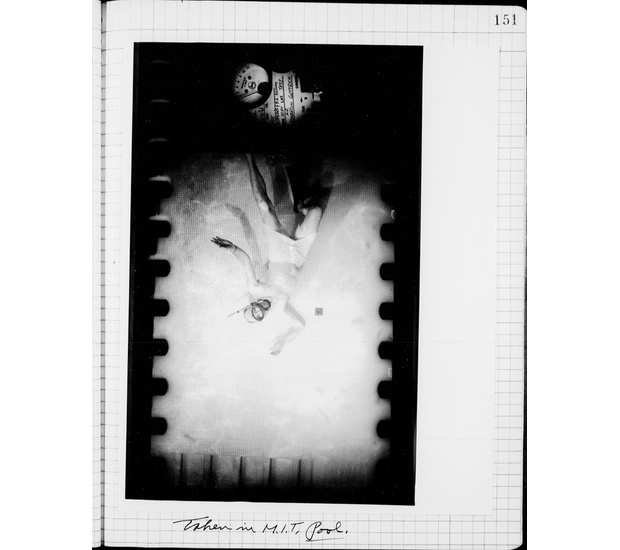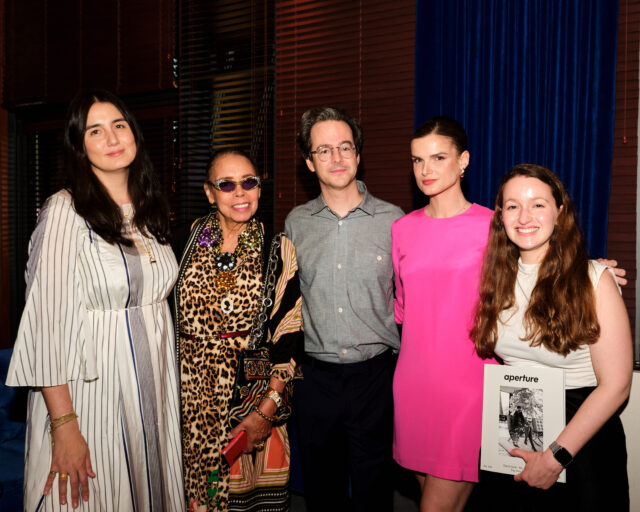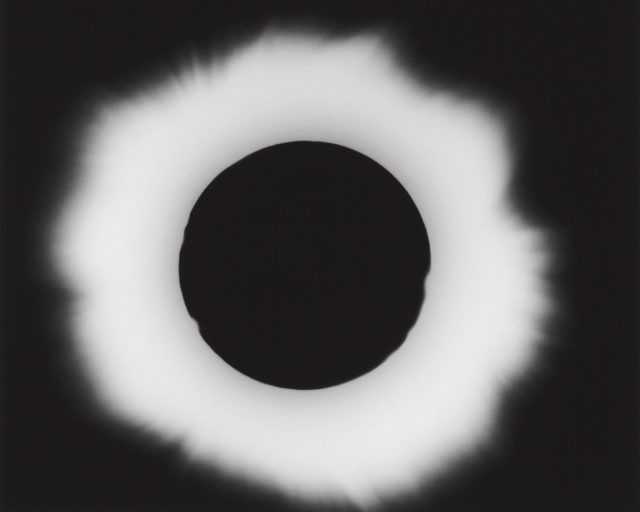Harold E. Edgerton—"Doc" Edgerton and His Laboratory Notebooks
“Let a cannon-bullet pass through a room, and in its way take with it any limb or fleshy part of man.” This dramatic scenario was envisaged by the great Enlightenment thinker John Locke in 1689. The bullet, he reasoned, “must touch one part of the flesh first, and another after, and so in succession.” But the action would happen so instantaneously that no one would be able to “perceive any succession, either in the pain or sound of so swift a stroke.” Our rational minds tell us that rapid events occur in a certain order, even though this order cannot be perceived. Since Locke’s early speculations, generations of researchers have worked hard to understand an increasingly fast-paced world. With the help of electronic flash, photographers were able to arrest Locke’s imagined projectile in midair: in the 1930s, Harold E. “Doc” Edgerton, working at the Massachusetts Institute of Technology, captured a rifle’s bullet flying at the vertiginous speed of 2,700 feet per second. The first use of flash is usually attributed to one of the inventors of photography, William Henry Fox Talbot. In 1851 Talbot used a simple electric spark to illuminate a moving target—a page of the London Times that was pinned on a rapidly rotating wheel. To his amazement, the resulting photograph was legible. At the turn of the century, the British physicist A. M. Worthington used sparks to illuminate splashing drops, and in France during the 1920s the Seguin brothers developed the “stroborama”— a machine made first with mercury and then with neon arc lamps. As scientists extended the field of flash illumination beyond the spark, they increased the range of their visual studies.
Edgerton’s first announcement of strobe technologies appeared in a 1931 issue of the journal Electrical Engineering. James R. Killian, a young science writer (later president of MIT and one of Dwight Eisenhower’s most trusted scientific advisors), was immediately fascinated by strobe lights. For more than forty years, Edgerton and Killian worked as a team: one taking the photographs and the other writing about the “meaning of the pictures.”
In 1932 Edgerton’s images were published in Technology Review, a student-run MIT journal edited by Killian, who also wrote the preface to Edgerton’s first book about strobe technology, the handsomely illustrated Flash! Seeing the Unseen by Ultra High-Speed Photography (1939). When the United States joined World War II, Edgerton went on active duty; his night-reconnaissance work (using a 40,000-watt-per-second xenon flash) won him the Medal of Freedom. Upon returning home, he cofounded a highly lucrative defense-contract business from which he and his partners made a munificent living. Among their many endeavors, they developed a shutterless “rapatronic” (“rapid” and “electronic”) camera that was able to photograph the first stages of superfast nuclear explosions. In 1954 Killian and Edgerton republished Flash!. The original 1939 edition had included a photograph of a golf club hitting a ball; in the later volume this image was replaced with one of an atomic bomb explosion. While much had changed during a decade and a half of war and Cold War, Killian’s preface to the book was unaltered. Edgerton was, Killian noted there, “first of all a scientist and an electrical engineer, investigating, measuring, seeking new facts about natural phenomena.” Nonetheless, Killian also insisted that “these pictures are not only facts, but new aesthetic experiences,” which he compared to Edward Weston’s cypress trees and rocks, Edward Steichen’s sunflowers, and Alfred Stieglitz’s clouds and hands. He described Edgerton’s images as “literal transcriptions” of nature, broadly fitting within a realist theory of representation. They were, Killian asserted, “scientific records” written in a “universal language for all to appreciate.”
For Edgerton himself, strobe photographs were something else: records of the unforeseen and the unexpected. As he would put it decades later: “A good experiment is simply one that reveals something previously unknown to the student.” Many aspiring young engineers arrived at his MIT Strobe Lab believing otherwise: “Some students expect the results to prove the initial assumption, but I have always empathized with the student who sees new discoveries and knowledge that were not anticipated flowing from the laboratory.” According to Edgerton, there was “no such thing as a ‘perfect’ result or a complete study of the phenomenon.” His laboratory notebooks, filled with notes, handscrawled diagrams, and snapshots documenting his work, reveal the flowing stage of production—often referred to as “science in action”—which belies the static, “ready-made” outcome presented at the end. In contrast to the published photographs, those in his lab notebooks show a different behind-the-scenes spectacle: most interestingly, scientists (including Edgerton himself) working their machines. Killian was not concerned with the production process of science or with unexpected results that could suddenly surface in real time. For a number of like-minded thinkers—including Aristotle and Albert Einstein—time was as predictable as space. Edgerton’s machines “manipulate time as the microscope or telescope manipulates space,” Killian wrote. Modern science “ enabled us to see and understand by contracting and expanding not only space but time.”
Edgerton was not as optimistic as Killian. “Although I’ve tried for years to photograph a drop of milk splashing on a plate with all the coronet’s points spaced equally apart, I have never succeeded.” But he was hardly disappointed: “In many ways, unexpected results are what have most inspired my photography.”
Edgerton expected the unexpected. In 1952 came an ultimate case in point: in approximately ten nanoseconds, one of the handheld cameras he and his associates had developed captured the initial stages of the first hydrogen bomb explosion, which obliterated Elugelab Island, part of the Enewetak Atoll in the Marshall Islands of the Pacific. Even those who had witnessed atomic tests were stunned by the bomb’s capacity for destruction: the explosion was more than twenty times the size of the Hiroshima fireball. Not only was Elugelab vaporized, but life on the surrounding islands was destroyed. Radiation blanketed most of the atoll, and hundreds of natives expelled from the island were left with nowhere to return to. As in Locke’s seventeenthcentury description, the pain on the ground did not match with the knowledge of the succession of events—this time on a scale never before imagined.
All images courtesy MIT Libraries, Institute Archives and Special Collections, Harold Eugene Edgerton Papers, Cambridge, Massachusetts. All rights reserved.




























